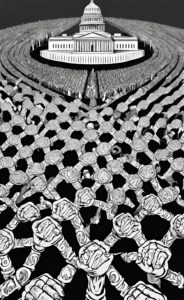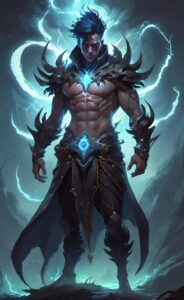In today’s socio-political landscape, the tension between different male archetypes, especially between the self-sufficient sigma male and the more conformist beta male, has seen a unique battleground, the use of government mechanisms. The nuanced ways in which beta males leverage government power to impose limitations and controls on sigma males, who are known for their independence, self-sufficiency, and disregard for hierarchical social structures, is an obvious problem for those who seek true freedom. The intersection of personal dynamics with political power unfolds a complex narrative where governmental tactics become tools in the silent war against the sigma male ethos.
Understanding the Sigma Male Archetype
Sigma males stand out due to their distinctive approach to life and society. They are the quintessential ‘lone wolves’, preferring solitude or the company of a select few over large social gatherings or traditional hierarchical structures. Their primary values center around freedom, independence, and self-reliance, traits that enable them to forge unique paths outside of societal norms. This archetype often finds fulfillment in personal accomplishments and the mastery of skills rather than in social status or the approval of others.
Unlike alpha males, who thrive on social dominance and leadership, sigma males operate independently, often avoiding the spotlight and conventional paths to success. Their disregard for social hierarchies doesn’t stem from a lack of capability but rather a deliberate choice to remain unbound by the constraints those systems impose. This makes sigma males highly adaptable and capable of achieving success on their own terms, which can sometimes be misconstrued as disinterest or disengagement from societal goals.
The sigma male’s preference for autonomy over conformity can lead to them being misunderstood by more traditionally oriented individuals. Their ability to exist comfortably outside of established social structures poses a challenge to the conventional understanding of success and power dynamics, often leading to friction between sigma males and those who find comfort within the boundaries of traditional societal roles. This unique perspective is not a result of social aversion but rather a deep-seated desire for genuine independence and the freedom to live according to one’s principles.
Beta Males’ Reliance on Government Structures
Beta males often find solace and a sense of belonging within the predictable confines of established systems. The structured environment provided by government frameworks appeals to their preference for order and predictability. This affinity for regulated spaces fosters a dependence on governmental authority, which, in turn, shapes their approach to navigating societal challenges. When confronted with the sigma male’s unconventional lifestyle and their marked disdain for societal norms, beta males may perceive a threat to the very structures that guarantee their sense of stability. This perceived threat motivates them to utilize government mechanisms to enforce conformity and maintain the societal hierarchy that validates their world view.
The beta male’s inclination towards leveraging government power is not merely a defensive strategy but also an attempt to affirm their own identity within the societal pecking order. By advocating for the enforcement of regulations and norms that restrict the sigma male’s way of life, beta males aim to cement their place within the social structure. This reliance on government as both shield and sword is indicative of their broader strategy to navigate life through adherence to and reinforcement of existing systems. Their actions reflect a deeper belief in the necessity of a structured societal framework to mediate and regulate interpersonal and intergroup dynamics, especially when faced with individuals who challenge or opt out of these traditional structures.
Legislation and Regulation as Tools of Control
Beta males often maneuver within the halls of power to craft and support legislative efforts that place constraints on the lifestyles and freedoms of sigma males. These legislative actions are subtly designed to weave a web of legal limitations around activities that define the sigma male’s autonomy. For instance, through the imposition of specific zoning laws, beta males ensure that sigma males face hurdles in establishing self-sufficient homesteads, effectively anchoring them closer to conventional societal frameworks. Similarly, business regulations can become disproportionately burdensome for sigma male entrepreneurs, who may seek innovative paths outside mainstream economic systems but find themselves entangled in red tape.
Notably, these legislative efforts are framed under the guise of public safety, environmental concerns, or community welfare, making opposition to them appear socially irresponsible. This clever framing allows beta males to mask their underlying intent of reining in sigma male independence while maintaining a façade of civic-mindedness. Additionally, the push for expanded surveillance laws under the pretext of national security can severely impede the sigma male’s desire for privacy and freedom from oversight, placing them under the watchful eye of a system they strive to remain apart from.
By championing such regulations, beta males not only curb the sigma male’s ability to live autonomously but also subtly signal to society that stepping outside accepted bounds is fraught with legal challenges. This legal labyrinth is meticulously engineered to dilute the essence of sigma male independence, compelling them to navigate a minefield of compliance that stands in stark contrast to their inherent drive for self-determination.

> Check Current Book Prices <
Social Programs and Dependency Creation
The strategy of leveraging social programs as a means to establish dependency illustrates a subtle yet effective method employed to challenge the autonomy of sigma males. These initiatives, often cloaked in the veneer of support and assistance, play a critical role in the broader agenda to embed reliance on governmental systems. For the sigma male, whose ethos is deeply rooted in self-reliance and the pursuit of independence, the proliferation of these programs represents an anathema to their core values. The encouragement, or in some instances, the requirement to partake in government assistance schemes, not only contradicts their principle of self-sufficiency but also maneuvers them into a position of indirect conformity.
This tactic, while promoting the outward appearance of benevolence and communal care, subtly erodes the foundational pillar of sigma male identity—autonomy. By architecting a societal framework where dependency is normalized, and in certain perspectives, glorified, beta males contribute to a narrative that diminishes the valorization of independence.
This narrative shift has profound implications, subtly nudging sigma males towards the margins of society, where their self-sufficient lifestyle becomes increasingly challenging to maintain. The nuanced implementation of these social programs, therefore, not only fosters a culture of dependency but also strategically undermines the very essence of what it means to live as a sigma male, further entrenching governmental power and influence over individual lives.



Surveillance and Data Collection as Means of Control
The digital era has transformed surveillance and data collection into cornerstone tactics for monitoring sigma males. Governed by beta males in authoritative roles, these strategies focus on meticulously tracking the online behavior, financial dealings, and personal communications of sigma individuals. This invasive oversight extends beyond mere observation, serving as a mechanism to thwart any efforts by sigma males to circumvent traditional societal frameworks. The scope of this surveillance is vast, encompassing everything from social media usage to mobile phone tracking, creating a pervasive environment where sigma males are constantly under watch.
This strategy of constant surveillance aims to dismantle the sigma male’s prized autonomy, subtly coercing them into alignment with conventional societal expectations. By monitoring their every move, beta males gather the necessary intelligence to intervene preemptively, blocking sigma males from fully exercising their independence. Furthermore, this surveillance serves a dual purpose: it not only restricts sigma male freedom but also reinforces the power dynamic, reminding sigma males of the omnipresent nature of governmental oversight.
The collection and analysis of personal data have become a key asset in this endeavor, enabling a targeted approach towards sigma males. Through the aggregation of vast datasets, beta males can predict, manipulate, and influence the behaviors of sigma males, further narrowing the avenues through which they can express their individuality. This digital observation is relentless, subtly eroding the foundations of sigma male independence, transforming the digital frontier into a battleground where privacy is the price of nonconformity.
The Media as a Beta Male Ally
The relationship between the media and beta males in their campaign against sigma males is a subtle yet impactful one. Through selective coverage and framing, the media often perpetuates a narrative that casts sigma males in an unfavorable light. By focusing on their refusal to conform to societal norms, media portrayals can paint sigma males as outliers who disrupt the social order, rather than as individuals exercising personal freedom. This narrative serves to validate the control and surveillance measures put in place by beta males, making the sigma male lifestyle appear problematic or undesirable to the general public.
In many cases, the media amplifies stories that underscore the perceived threat sigma males pose to conventional ways of living, ignoring the positive aspects of their independence and self-reliance. This biased portrayal creates a climate of misunderstanding and fear, making it easier for beta males to justify the imposition of restrictions and oversight on sigma males. Furthermore, by frequently highlighting conflicts between sigma males and societal norms, the media inadvertently supports the beta male agenda of promoting government dependency and conformity.
This alignment, whether conscious or not, bolsters the beta male’s position within the social hierarchy, lending credence to their use of government mechanisms against sigma males. It also plays a crucial role in shaping public opinion, subtly nudging the populace to view sigma male characteristics with skepticism or disdain, thereby further isolating sigma males and making their pursuit of independence more challenging in the face of societal and governmental pressures.









